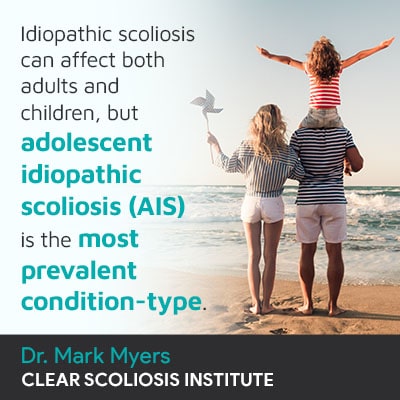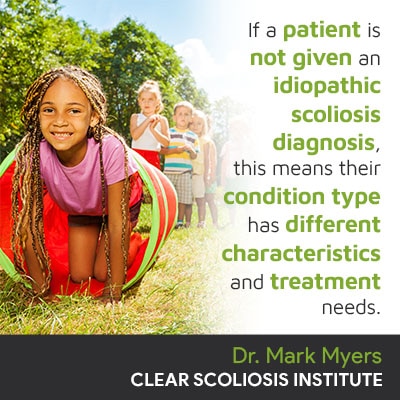
When a scoliosis diagnosis is given, part of the assessment process involves further classifying the condition based on important patient and condition variables: age, curvature location, severity, and causation. In order for treatment to be effective, it has to address the condition’s underlying cause, or only symptoms of the condition are being addressed, and not the underlying condition itself.
Not only can scoliosis range greatly in severity, there are also different condition types with varying etiologies. Idiopathic scoliosis is the most prevalent type, and the idiopathic classification means it’s not clearly associated with a single causative source.
Before getting into the specifics of idiopathic scoliosis, let’s first define the condition by exploring some of its important characteristics.
If a person is diagnosed with scoliosis, it means they have an unnatural sideways spinal curve, with rotation, and a minimum Cobb angle of 10 degrees.
A scoliotic spine doesn’t just bend unnaturally to the side, it twists from front to back, back to front, making it a 3-dimensional condition.
As a progressive condition, scoliosis has it in its very nature to worsen over time, which is why proactive treatment is so important.
Scoliosis can range in severity from mild to moderate and severe, and condition severity is determined by a measurement known as Cobb angle.
A patient’s Cobb angle is determined during X-ray by drawing lines from the tops and bottoms of the most-tilted vertebrae (bones of the spine), at the apex of the curve.
The resulting angle is measured in degrees and further classifies conditions as mild, moderate, or severe:
In addition to patient age, curvature location, and condition severity, causation is an important classification point that shapes the design of effective treatment plans moving forward.
Part of giving an idiopathic scoliosis diagnosis is explaining to patients, and their families, what it means when a condition is classified as idiopathic.
While idiopathic means not clearly associated with a single causative source, this isn’t the same as having a complete absence of a cause; instead, idiopathic scoliosis is, considered to be multifactorial, meaning caused my multiple factors that can vary from one person to the next.
While it can be difficult for patients to understand that we don’t know why they developed the condition, I remind them that we most certainly know how to treat it effectively, and knowing the initial cause wouldn’t necessarily change the course of treatment, nor its efficacy.

Idiopathic scoliosis is, also, the most common condition type to affect adults, followed by degenerative scoliosis, and cases of adult idiopathic scoliosis are cases of AIS that were undiagnosed and untreated in adolescence.
What is Adolescent Idiopathic Scoliosis?
Adolescent idiopathic scoliosis is diagnosed between the ages of 10 and 18, and while we don’t fully understand the etiology of this condition type, we do understand its main trigger for progression: growth and development.
This age group is at risk for rapid-phase progression because of the stage of puberty these patients are in, or entering into, which is characterized by rapid and unpredictable growth spurts.
One of the goals of treatment for AIS is to stay ahead of a patient’s progressive line to counteract the big trigger of growth and development they are facing.
One of the reasons that idiopathic scoliosis is the most prevalent form of adult scoliosis is because, despite the potential benefits of early detection, the telltale signs of AIS aren’t always overt, and in mild forms, don’t commonly cause noticeable functional deficits.
In addition, scoliosis doesn’t become a compressive condition until skeletal maturity has been reached in adulthood, and this is when the condition tends to start producing more-noticeable symptoms: pain is the number one symptom of idiopathic scoliosis in adults.
For children and adolescents, the lengthening motion of a growing spine counteracts condition-related compression of the spine. and its surrounding muscles and nerves, which is the main cause of pain, and in some cases, it’s not until idiopathic scoliosis has progressed with maturity and growth, becoming compressive and painful, that an actual diagnosis is given.
Pain is the main difference between how adolescents and adults experience idiopathic scoliosis, and while each case is unique and shaped by important patient/condition variables, the most common symptoms of AIS involve postural deviation:
Due to the uneven forces that scoliosis introduces to the body, it disrupts the body’s overall symmetry, causing related postural changes, and in addition, clothing can become ill-fitting, and changes to gait, balance, and coordination are additional signs of idiopathic scoliosis.
Idiopathic Scoliosis Diagnosis
As mentioned earlier, part of the diagnostic process involves further classifying conditions based on important variables.
Now that we’ve discussed patient age, and how it affects important condition variables such as experienced symptoms and progression, let’s address other causative sources of scoliosis.
As mentioned, idiopathic scoliosis is the most common condition type, but there are other forms of scoliosis with clear causative sources: degenerative, neuromuscular, congenital, and traumatic.

After idiopathic scoliosis, degenerative scoliosis is the most common type to affect adults, and this is caused by natural age-related spinal degeneration, most commonly involving the intervertebral discs, so if disc issues are the cause, treatment will be shaped around restoring disc health/function.
When a neuromuscular scoliosis diagnosis is given, this means that an underlying neuromuscular condition is the cause of the scoliosis development, so the larger neuromuscular condition at the root of the scoliosis development will be the guiding force of treatment.
Congenital scoliosis develops in utero due to a malformation within the spine itself, and this is a rare form affecting approximately 1 in 10,000 infants.
In cases of traumatic scoliosis, the unnatural spinal curve develops because of injury/trauma experienced by the spine; in addition, the presence of tumors pressing on the spine can also apply enough uneven pressure to disrupt the spine’s ability to maintain its natural curvature and alignment.
So you can see how a condition’s underlying cause plays into how effective treatment can be because treatment that only addresses symptoms of scoliosis is not the same as treating the underlying cause of the symptoms: the condition itself.
So once an idiopathic scoliosis diagnosis has been given, what are the treatment options available?
Following an idiopathic scoliosis diagnosis, or any scoliosis diagnosis for that matter, the most important decision moving forward is how to treat it effectively.
There are two main approaches to scoliosis treatment, each offering patients different potential outcomes: traditional and conservative.
Traditional scoliosis treatment has been in place for many years, but despite our growing understanding of the condition and how it responds to treatment over those years, the traditional approach has changed little.
The traditional approach can be described as more reactive than proactive because it values watching and waiting and doesn’t apply treatment until a certain level of progression has already occurred, which is wasting valuable treatment time as the curve is allowed to progress unimpeded.
As a result, patients following the traditional path of scoliosis treatment are commonly funneled towards spinal fusion surgery.
As a CLEAR-certified scoliosis chiropractor, I treat patients with a conservative chiropractic-centered treatment approach that values proactive treatment applied as close to the time of diagnosis as well; this is because, as a progressive condition, we know that, at some point, virtually every case of scoliosis is going to progress.
It’s simpler to treat a scoliotic curve while it’s at its smallest, hasn’t yet experienced significant progression, increasing spinal rigidity, and before the body has had ample time to adjust to the unnatural curve’s presence.
Most importantly, being proactive with treatment can help patients avoid the hardships associated with increasing condition severity and the need for more invasive forms of treatment in the future.
By integrating multiple condition-specific forms of treatment, such as chiropractic care, in-office therapy, custom-prescribed home exercises, and corrective bracing, I can help patients work towards addressing any areas of spinal subluxation, and increasing core strength so the spine receives optimal support and stabilization from its surrounding muscles.
By restoring as much of the spine’s natural curves as possible, its overall biomechanics are improved, its function is preserved, and the condition has been impacted on multiple levels, including structurally.
Part of the reason scoliosis is so often deemed a complex and/or mysterious condition is because in addition to developing across a wide severity spectrum, there are also multiple different condition types.
While idiopathic scoliosis is the most common form to affect adolescents and adults, there are condition types with clear etiologies such as degenerative, neuromuscular, congenital, and traumatic scoliosis.
While there are never treatment guarantees, as a CLEAR-certified scoliosis chiropractor, I can help patients, both adolescent and adult, treat their idiopathic scoliosis by customizing treatment plans around important patient/condition variables such as patient age, curvature location, severity, and causation.

CLEAR provides a unique and innovative way of understanding scoliosis. Sign up to receive facts and information you won’t find anywhere else.
